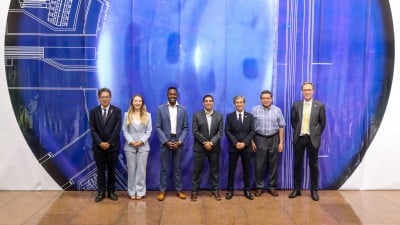Science
Princeton Lab Enhances World’s Largest Fusion Reactor with US Tech

The Princeton Plasma Physics Laboratory (PPPL) has secured a significant role in the development of the world’s largest superconducting fusion machine, known as **JT-60SA**. This project represents a crucial step in advancing fusion energy technology, with PPPL providing essential measurement technology for plasma analysis. This collaboration marks one of the first contributions from an institution outside of Japan and Europe, expanding the global effort towards sustainable energy solutions.
Located in Naka, Japan, the **JT-60SA** aims to improve understanding of plasma behavior, which is vital for the future of nuclear fusion energy. The collaboration is part of a broader initiative to harness fusion as a clean energy source, addressing global energy demands while minimizing environmental impact.
Collaboration for a Sustainable Future
The partnership between PPPL and the JT-60SA project underscores the importance of international cooperation in scientific research. The **Princeton Plasma Physics Laboratory**, a renowned center for fusion energy research, will contribute advanced diagnostic tools that measure plasma conditions within the reactor. These tools are critical for optimizing fusion reactions and ensuring the safety and efficiency of the system.
The **JT-60SA** project is a joint venture primarily funded by Japan, with contributions from the European Union and other international partners. The involvement of PPPL signifies a growing recognition of the need for diverse expertise in tackling the complex challenges associated with fusion technology.
Impact on Global Energy Research
As governments worldwide seek innovative solutions to combat climate change, fusion energy remains a promising option. Unlike traditional fossil fuels, fusion has the potential to provide a nearly limitless source of energy without the harmful emissions associated with burning carbon-based fuels. The successful development of **JT-60SA** could pave the way for future advancements in fusion reactors, bringing the world closer to realizing practical fusion energy.
The project is expected to play a pivotal role in the **International Thermonuclear Experimental Reactor (ITER)** initiative, further cementing its position as a cornerstone of global efforts to achieve sustainable energy. With the support of institutions like the Princeton Plasma Physics Laboratory, researchers are optimistic about the potential breakthroughs that could emerge from this collaborative endeavor.
Through this partnership, the PPPL is not only contributing to the technical aspects of fusion energy but also reinforcing the value of international teamwork in addressing pressing global issues. As the **JT-60SA** continues its development, it stands as a testament to the collective ambition of scientists and engineers dedicated to creating a greener, more sustainable future.
-

 Science2 months ago
Science2 months agoInventor Achieves Breakthrough with 2 Billion FPS Laser Video
-

 Health2 months ago
Health2 months agoCommunity Unites for 7th Annual Into the Light Walk for Mental Health
-

 Top Stories2 months ago
Top Stories2 months agoCharlie Sheen’s New Romance: ‘Glowing’ with Younger Partner
-

 Entertainment2 months ago
Entertainment2 months agoDua Lipa Aces GCSE Spanish, Sparks Super Bowl Buzz with Fans
-

 Health2 months ago
Health2 months agoCurium Group, PeptiDream, and PDRadiopharma Launch Key Cancer Trial
-

 Top Stories2 months ago
Top Stories2 months agoFormer Mozilla CMO Launches AI-Driven Cannabis Cocktail Brand Fast
-

 Entertainment2 months ago
Entertainment2 months agoMother Fights to Reunite with Children After Kidnapping in New Drama
-

 World2 months ago
World2 months agoIsrael Reopens Rafah Crossing After Hostage Remains Returned
-

 Business2 months ago
Business2 months agoTyler Technologies Set to Reveal Q3 Earnings on October 22
-

 World2 months ago
World2 months agoR&B Icon D’Angelo Dies at 51, Leaving Lasting Legacy
-

 Health2 months ago
Health2 months agoNorth Carolina’s Biotech Boom: Billions in New Investments
-

 Entertainment2 months ago
Entertainment2 months agoRed Sox’s Bregman to Become Free Agent; Tigers Commit to Skubal









